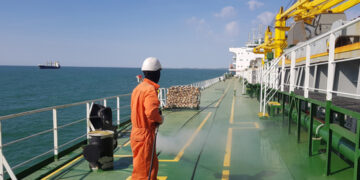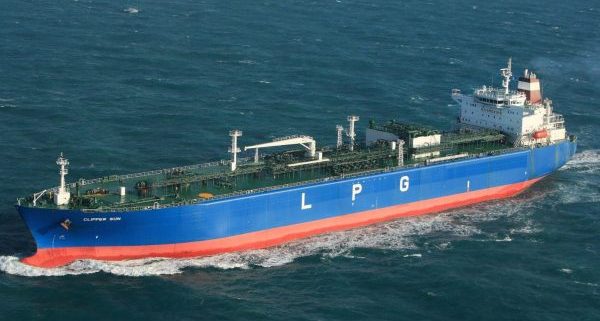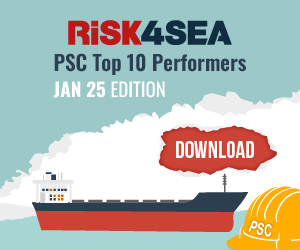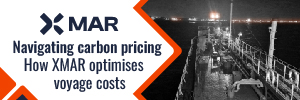ITOPF has published a report focusing on LPG as a non-traditional marine fuel highlighting the unique impacts associated with the fuel’s properties.
According to the report “Fate, Behaviour, Potential Damage & Liabilities Arising from a Spill of LPG in the Marine Environment”, LPG is being seen as a viable alternative fuel outside of the LPG carrier fleet, especially in a multi-fuel system. As the number of vessels with the ability to use LPG as fuel increases in the future, an increased likelihood of incidents occurring during handling, transportation, and loading/unloading operations exists.
For this reason, it is important that appropriate measures are in place to safeguard the health of the crew and other relevant parties. There are specific requirements already in place for, inter alia, storage, distribution, and personal protective equipment (PPE) under the International Code of the Construction and Equipment of Ships Carrying Liquefied Gases in Bulk (IGC Code).
The future possible widespread use of LPG as a shipping fuel creates new challenges related to safe fuel bunkering, storage, supply and consumption for different ship types.
Fate and behaviour of LPG spilled in the environment
The Standard European Behaviour Classification (SEBC) categorises LPG as a gas (G). During an incident, LPG’s hazards will be the drivers for the first actions and emergency response, followed by specific actions linked to its behaviour.
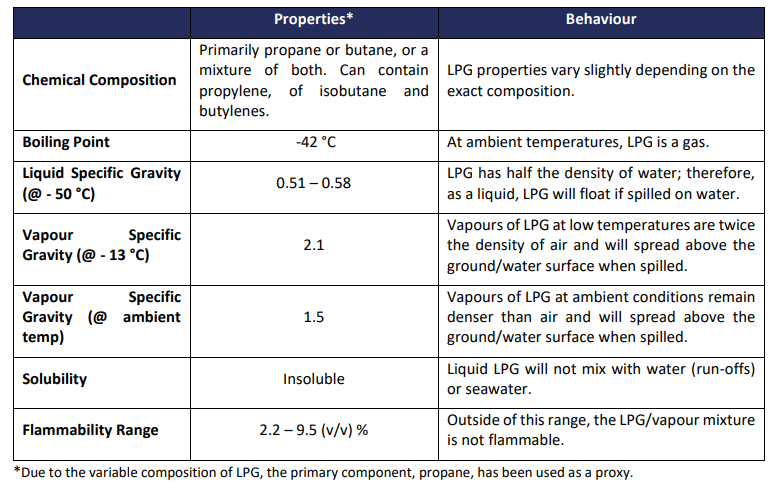
In its transported and stored form as a liquid, when the storage tank temperature rises above LPG’s boiling point or when liquid LPG is exposed to ambient conditions, it vaporises. If the liquid LPG spills on or above the waterline, it will first float and, depending on the quantity spilled, may form a shallow pool on the surface of the water before vaporising.
Furthermore, if the LPG was refrigerated within the tank, it is also possible for some of the seawater in the immediate vicinity of the release to freeze due to LPG’s low temperature, causing localised ice formation. As LPG is insoluble in water, it is not expected to mix into the water column.
If released below the waterline, due to its specific gravity, it will rise to the surface of the water before rapidly boiling and volatilising into the atmosphere. When vaporising, the LPG vapours are heavier than air and will form a dense cloud that will travel downwind staying close to the ground or sea.
Hazards of LPG when spilled in the marine environment
LPG’s hazards can lead to direct impacts on health and safety, mainly through its flammability and its explosivity.
Flammability
Liquid LPG is not flammable; however, its vapour has a flammability range of 2.2 – 9.5 (v/v) %, which can be detected with specialised equipment. Outside of this range, the LPG/air mixture is not flammable. This is of similar magnitude to conventional fuels such as diesel, which has a slightly smaller flammability range of 0.6 – 5.5 (v/v) %.
In an unconfined space, a release of LPG from a tank or pipeline will rapidly volatilise and its vapours will spread over the ground/water surface. Only a small area near the source of the leak would likely reach the concentration that would allow LPG to ignite. The extent of the vapour cloud spreading will mainly depend on the rate of the spill and the metocean conditions. Even in moderate wind speeds, an ignition of the vapour cloud and subsequent fire may still be able to propagate back to the leak source until all the LPG is consumed below the lower flammability limit (LFL) or is extinguished.
In a confined space, where flammable vapours cannot spread and dissipate, a small leak could lead to a flammable vapour/air mixture. Note that inside a fuel storage tank, the percentage of LPG is almost pure and, as such, the conditions are not within its flammability range.
However, following a leak/rupture, a dense vapour cloud will form and once it has mixed with air, when its concentration reaches between the LFL and the upper flammability limit (UFL), the mixture can sustain a flame if ignited. If ignition occurs immediately, a non-pressurised leak will most likely result in a pool fire, which will continue until all the fuel is consumed, whereas a pressurised leak could lead to a torch or jet fire.
The flames from these are typically confined to a small localised area, but can result in additional hazards if the jet fire impinges on an adjacent fuel tank.
Explosivity
If LPG vapours concentrate in a confined space, there is a significant risk of combustion, meaning that an invisible spark or hot surface may cause ignition, possibly leading to an explosion.
Compressed LPG
LPG released in sufficient quantities can create a harmful overpressure which may result in direct and indirect hazards from building damage or flying debris. Overpressures can occur as a result of unignited releases of pressurised gas or as a result of ignition of a cloud of flammable gas.
Refrigerated LPG
In particular conditions, there is a possibility that spilled LPG could potentially undergo a boiling liquid expanding vapour explosion (BLEVE), which is an explosion caused by the rupture of a tank containing a pressurised liquid that has reached a temperature above its boiling point of -42 °C. This would be the case if the temperature of the tank were to raise and gas release systems were to fail.
Asphyxiant
Like with any gas in a confined environment, high concentration of LPG vapours displace oxygen in the air, decreasing oxygen availability and therefore leading to asphyxiation to those present in these confined environments.
Temperature
The low temperature of liquid LPG will result in the freezing of any tissue (plant or animal) upon contact and can cause materials to become brittle and lose their strength or functionality.
Damage and liabilities arising from incidents involving LPG
Clean-up and Preventive Measures
In comparison to the costs associated with clean-up and preventive measures from a traditional spill of persistent hydrocarbon bunker fuel oil, the costs for this claim heading for a spill of LPG would likely be for different measures, primarily source control.
LPG’s non-persistence in the marine environment, means established oil pollution clean-up measures are inappropriate (e.g. collection and recovery using booms and skimmers). Spilled LPG is not recoverable and therefore allowing natural attenuation to occur is the only appropriate option.
Personal Injury and Loss of Life
This claim heading is included within the HNS Convention for LPG cargoes and has particular relevance to spills involving LPG bunkers.
Environmental Damage
The environmental impact of LPG in the marine environment is not as widely researched as the impact associated with spills of other, more persistent, hydrocarbon oils. However, due to the fate, behaviour and chemical characteristics of the constituents of LPG, only a short-term, acute negative impact in the immediate vicinity of the incident location is expected.
Property Damage
Costs arising for property damage will be spatially confined to properties in close proximity to the incident.
Economic Loss
Economic loss can be split into “consequential loss”, whereby compensation is payable for loss of earnings suffered by the owners of property, which have been impacted and “pure economic loss”, whereby compensation is payable for loss of earnings suffered by persons whose property has not been impacted. In the event of an LPG incident, both consequential and pure economic loss could be experienced.
In conclusion, LPG’s short residence time in the marine environment and high volatility means that claims arising from incidents involving this alternative fuel would greatly contrast those associated with conventional persistent hydrocarbon oil spills.







